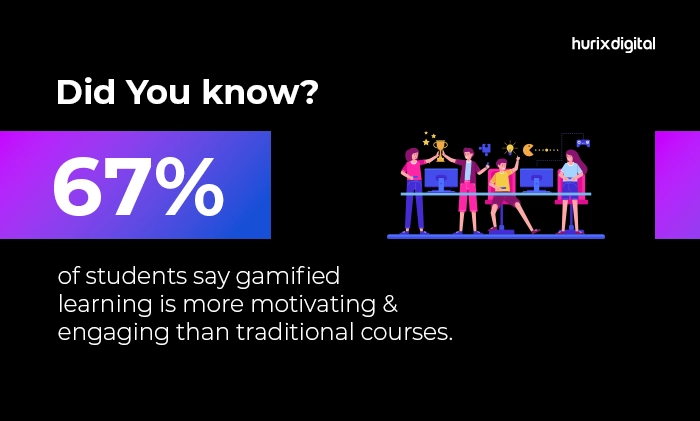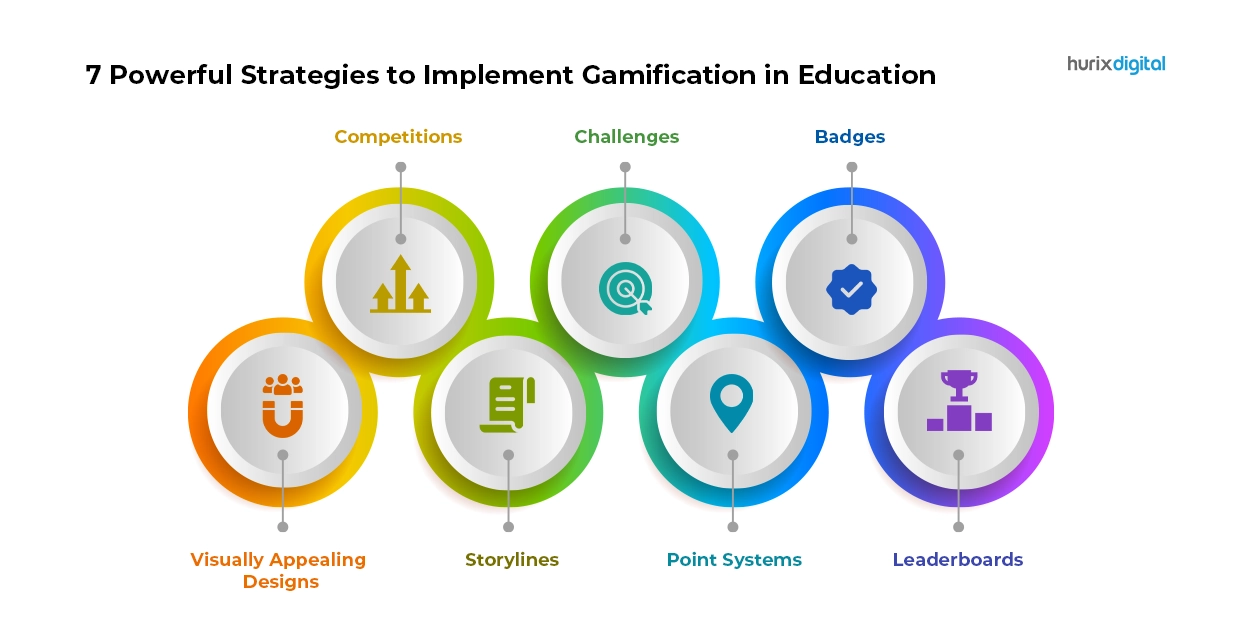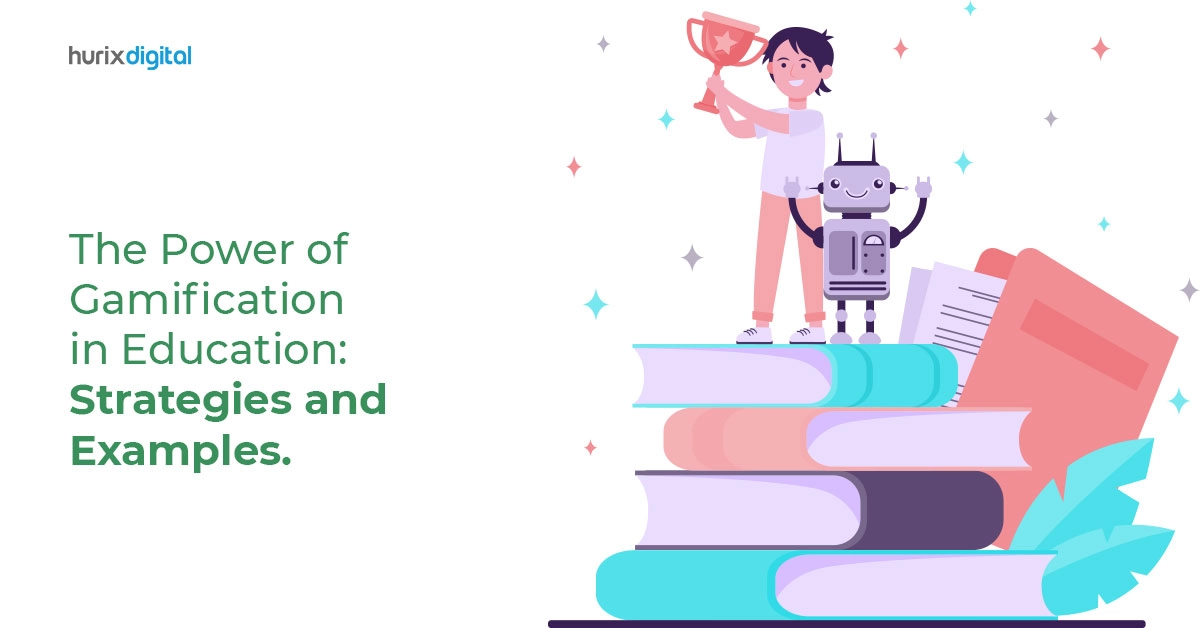Gamification in Learning: 7 Powerful Strategies to Implement
Summary
Discover seven potent strategies to implement gamified learning and transform educational experiences. Harness the power of gamification to enhance engagement, motivation, and knowledge retention. From interactive quizzes to immersive simulations, explore innovative approaches to make learning enjoyable and effective. Elevate your teaching methods and empower learners with gamified education.
Staying relevant in the ever-evolving higher education landscape involves constantly re-evaluating the current learning processes and implementing new strategies to boost the students’ learning experiences.
One such concept that is gaining popularity in the education sector is gamification in learning, a process that utilizes game elements to enhance learning. In the United States alone, around 227 million people play games every week, and worldwide, there are around three billion video game players.
Gamification is a great way of enriching education using components of a widely popular medium. It complements the traditional methods of imparting education and e-learning and can boost the overall learning experience in many ways.
Table of Contents:
- What is Gamification in Learning?
- Top 7 Powerful Strategies to Implement Gamification in Education
- Eight Examples of Gamification in Learning
- Why Hurix Is the Best to Help You in Implementing Gamification in Education
What is Gamification in Education?

Gamified learning revolutionizes education by integrating game elements into instructional frameworks, fostering heightened engagement and motivation among students. By leveraging gaming components, this innovative approach enriches the learning journey, making it more immersive and enjoyable for learners, thereby maximizing retention and academic success.
Games have numerous elements that make them impactful means of imparting learning. They are structured to solve problems, boost teamwork, improve communication skills, and encourage healthy competition with other members.
Games also help spawn innovation, imagination, and creativity in the participants. By introducing gamified learning in education, one can aim for the following benefits:
- Higher learner motivation levels
- Increased knowledge retention
- Better student engagement
- Instant feedback and reinforcement
- More enjoyable educational experience
Incorporating elements of gamified learning into educational models not only enhances the learning experience but also fosters motivation, engagement, and creativity among students.
Top 7 Powerful Strategies to Implement Gamification in Education

There are numerous ways to incorporate gaming components into learning modules for students and corporate training programs. Effective gamification strategies take gaming elements that are intriguing, motivating, and exciting and merge them with learning programs to enhance their effectiveness.
Given below are some great gamification strategies that are known to work wonders.
1. Visually Appealing Designs
Aesthetically pleasing designs and fun colors can make the learning process much more interesting and fun.
Include bright, sunny colors in your e-learning portals to add a friendly and warm vibe that is inviting to the senses. Add ample figures and graphics to make the content more engaging.
2. Competitions
Competitions are a fabulous way to encourage healthy competition among your learners. Gamification allows ample scope to inculcate competitive elements in educational and training programs.
Students can compete against themselves, other team members, or even anonymous players in these competitions.
3. Storylines
Creating a compelling storyline is a sure-shot way to capture the attention of the learners and keep them engaged. This is a good way to maintain interest in the task at hand, especially when it comes to immersive learning modules.
One can create avatars representing each learner to incorporate extra fun into the gamification process.
4. Challenges
One of the most exciting elements of playing games is overcoming challenges at different stages. This enjoyable component of gaming has a significant role to play in gamification in education.
Providing small, progressively difficult challenges at frequent intervals to the learners helps them practice what they learned and prepare themselves for bigger challenges as the course progresses.
5. Point Systems
Just like in actual games, gamification can also use the point system to reward and motivate students in their educational journey.
The learners can be assigned points for completing different tasks within a specified time limit.
6. Badges
Who doesn’t love collecting badges while playing games? The same rule applies to gamification in education.
Badges are simply awards that acknowledge and reward people for their efforts. It is typically in the form of a pinned image on one’s profile.
It is a lovely way of showing the learners that their hard work and efforts are recognized and rewarded.
7. Leaderboards
Leaderboards are scoreboards used in actual games. With gamification, leaderboards can be used to track performances and foster healthy competition among learners.
The students would be excited to be featured on the leaderboards and work harder to achieve their goals so that they can see their names on top.
Hurix Mini-Book:
Immersive Learning for the WIN in Education!
Eight Examples of Gamification in Learning
Now that you know what kind of strategies to implement to introduce gamification, let us take a look at some examples.
1. Recognize Meeting Academic Objectives
Students who meet their academic objectives can be given points for encouragement. This can also help track their progress.
2. Acknowledge Accomplishing Non-Academic Objectives
Acknowledge education as a holistic concept that extends beyond just academic achievements. Appreciate and recognize the achievement of non-academic objectives to promote the students’ overall development.
3. Track Personalized Performance
Tracking and reflecting upon the personalized performance of each learner helps to identify their strengths and weaknesses.
The students can also self-assess their learning journey, which gives them the motivation to keep moving forward to achieve their goals.
4. Creating Engaging Barriers
One can create academic, non-academic, social, creative, logistical, or behavioral barriers to make educational modules more engaging. Overcoming these barriers helps foster motivation in the learners.
5. Fostering Healthy Competition
Competition is an inherent part of gamification. Setting up activities that foster healthy competition among students helps them develop a sense of sportsmanship.
6. Gamified Quizzes
Timed quizzes are often stressful for students. Make online timed quizzes more engaging and fun by gamifying them with components like bonus points, star ratings, rewards, and badges alongside basic point scoring.
7. Nuanced Ways of Appraising Performance
The learners’ performance can be broken down into numerous elements at the end of the educational program.
Breaking down the elements provides different ways of appraising their performances and aids in identifying their strengths and weaknesses.
8. Creating Unique Rewards
Instead of assigning points for every task that has been achieved, the educator can create a range of unique rewards for different sets of students.
This makes learning more interesting and breaks the monotony of assigning points for everything.
Why Hurix Is the Best to Help You in Implementing Gamification in Education
Are you looking to implement gamification in learning in your educational models to enhance the way education is imparted to your students? Get in touch with the experts at Hurix to implement the best gamification strategies to make education more impactful.
Hurix Digital is an industry leader in providing customized higher education and e-learning solutions to corporations and educational institutions. We understand the importance of constantly implementing alternative learning methods in educational methods to boost the overall efficacy of learning modules.
Reach out today to begin!

Senior Vice President
A Business Development professional with >20 years of experience with strong capability to sell new solutions and develop new markets from scratch. New Market Entry Specialist with experience working in the largest emerging markets. Exceptional experience in conceptualizing, ideating and selling new learning technologies like VR AR, etc. across multiple industry verticals.









